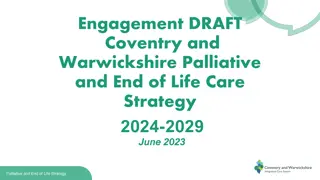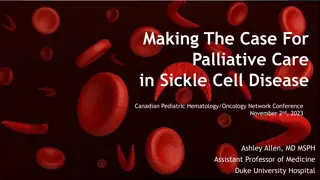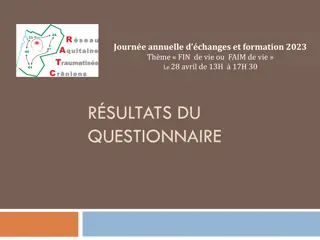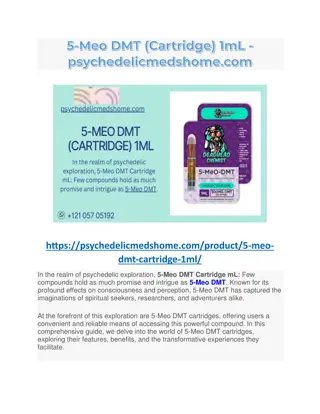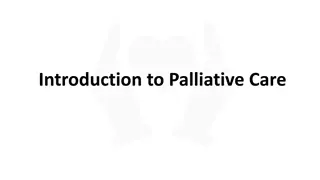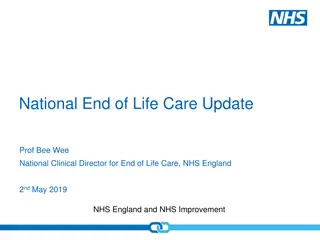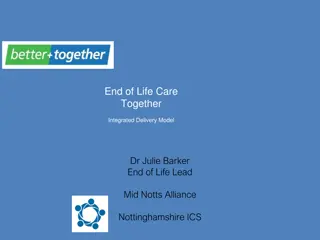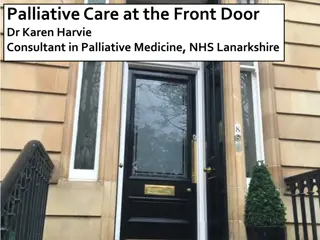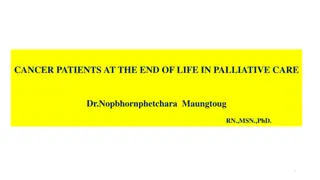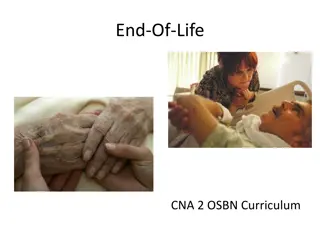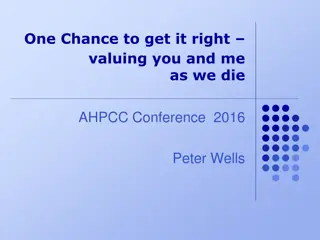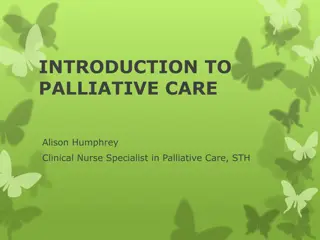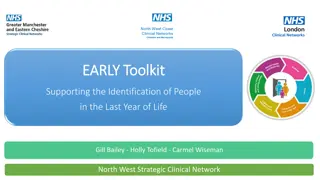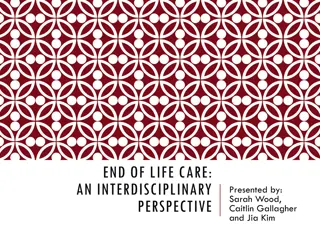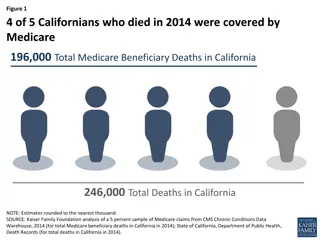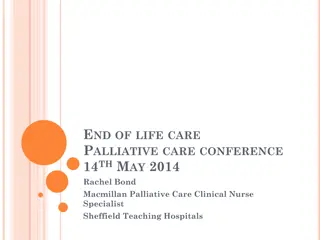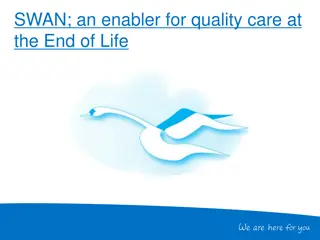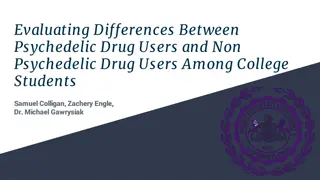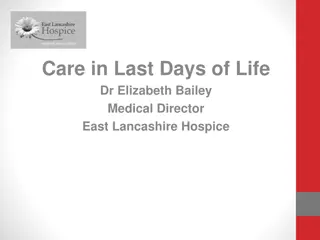Exploring End-of-Life Psychedelic Care with Christine Caldwell
Christine Caldwell, Founder of End of Life Psychedelic Care, introduces a novel treatment model using psychedelics like Psilocybin, MDMA, and Ketamine to ease anxiety, reduce pain, and bring meaning to life. The therapy involves altered states of consciousness, enhancing neuroplasticity and memory regions in the brain, leading to profound subjective effects and opening critical social reward periods. Join the journey in understanding the benefits and potential impacts of psychedelic therapy in end-of-life care.
Download Presentation

Please find below an Image/Link to download the presentation.
The content on the website is provided AS IS for your information and personal use only. It may not be sold, licensed, or shared on other websites without obtaining consent from the author. Download presentation by click this link. If you encounter any issues during the download, it is possible that the publisher has removed the file from their server.
E N D
Presentation Transcript
END OF LIFE PSYCHEDELIC CARE Christine Caldwell February 14, 2024
CHRISTINE CALDWELL Founder/Executive Director, End of Life Psychedelic Care Graduate, 12-month Psychedelics Today Vital Therapies and Integration Program Owner, 250-client home health care agency in Sarasota and sold it to Empath/Tidewell
AGENDA The Psychedelics The Research Health considerations Stories
THE PSYCHEDELICS Psilocybin MDMA Ketamine
Psychedelics: A Novel Treatment Model Active Coping vs Passive Coping Transdiagnostic mechanism of action treatment approach Neuroplasticity: enhanced learning and opening of critical periods Mystical Experiences Social and Nature Connectedness Benefit dependent on mindset and the setting Integration is a key part of the therapeutic benefit
Potential Benefits Ease anxiety and depression Reduce chronic pain Reduce fear of dying Learn to live in the present moment Bring purpose and meaning to life Experience a oneness with the universe and humanity Bring a sense of awe and wonder to the next place
KEY SIMILARITIES Creates altered states of consciousness Reduces anxiety, depression, PTSD, and more Involves memory/learning regions of the brain Increases neuroplasticity Opens Critical Social Reward Period
ACUTE SUBJECTIVE EFFECTS & OPEN CRITICAL PERIOD Ketamine: SE=30min-2hrs /CPO=48 hrs Psilocybin and MDMA: SE=3-6hours/ CPO=2 weeks LSD: SE=8-10hrs/CPO=3wks Ibogaine: SE=36-72hrs /CPO=4 weeks https://www.nature.com/articles/s41586-023-06204-3
DIFFERENCES: ALTERED STATES OF CONSCIOUSNESS
GLOBAL CONNECTIVITY https://royalsocietypublishing.org/doi/full/10.1098/rsif.2014.0873
Some Key Differences: Psilocybin Classic Psychedelic, Serotonergic System Quiets the Default Mode Network Considered one of the gentlest on the body Higher potential for Mystical Experience Can bring issues front and center 4-6 hours Journey Duration No known lethal dose, non-addictive Imperial College of London/Reuters
Psilocybin 90 80 70 60 50 40 30 20 10 0 Johns Hopkins 2016 NYU 2016 Sunstone Therapies 2023 % Reduction in Anxiety % Reduction in Depression % Reduction Depression at 18 mos https://old-prod.asco.org/sites/new- www.asco.org/files/content- files/Sunstone_Therapies_virtual_press.pdf https://www.ncbi.nlm.nih.gov/pmc/arti cles/PMC5367557/. https://journals.sagepub.com/doi/10.1177/02 69881116675512
Psilocybin Studies* MDAnderson: Depression in Gynecological Cancer Patients Sunstone Therapies: Major Depression Dana-Farber/CareDimensions Hospice: Demoralization UCLA and UCSF: Demoralization with Ketamine as Active Control Johns Hopkins: Depression in MCI/Early Alzheimer s Patients University of Colorado/NYU: Existential Distress University of Washington: Anxiety Emory University: Demoralization and Chronic Pain Diamond Therapeutics/University of Alabama: Microdosing *clinicaltrials.gov
Some Key Differences: MDMA Empathogenic, works on Serotonergic, Dopaminergic, Norepinephrinergic Increases activity in Prefrontal Cortex, decreases activity in Amygdala Mystical Experiences are rare 6-8 hours Journey Duration Risk of Serotonin Toxicity at very high doses
MDMA Dyad Study: Sunstone Therapies I realize MDMA has just allowed me to rewrite the script of a major traumatic life experience. Death suddenly loses its sting. Keeping depression at bay and having a loving relationship will still require attention, but after MDMA, it no longer seems like work. Kurt Nemes clinicaltrials.gov
Some Key Differences: Ketamine Dissociative Anesthetic, Glutamatergic System NMDA Antagonist creating surge of Glutamate Binds to the TrkB receptor and can mimic BDNF Binds to the Mu Opioid Receptor Shown to effectively treat chronic pain Fast acting but short lasting Puts you into Observer Mode 45-75 minutes Journey Duration Lethal in very high doses and potentially addictive
MAJOR ROUTES OF ADMINISTRATION IV (100%): In-clinic Typically start at .5mg/kg and titrate Injection (93%): In-clinic/At-home Typically delivered in two doses Nasal Spray (<50%): In-clinic/At-home Spravato: FDA approved - can be reimbursed Compounded Nasal Spray for at-home use Lozenge/Troche (<30%): At-home Can be used rectally, bypasses liver At-home to extend duration of pain and mental health relief
Ketamine Research in Hospice Patients % Sig Reduction in Depression % in Remission 75 50 25 0 University of Toronto https://pubmed.ncbi.nlm.nih.gov/23805864/ https://pubmed.ncbi.nlm.nih.gov/36672348/
Ketamine Therapy in Hospice Patients https://jdc.jefferson.edu/cgi/viewcontent.cgi?article =1069&context=petfp
Ketamine Therapy in Palliative Care https://pubmed.ncbi.nlm.nih.gov/31090477/
Ketamine Studies* PharmaTher: Reduce Dyskinesia in Parkinson s patients Cedars Sinai LA: Reduce Anxiety in Pancreatic Cancer Patients Yale University/Michael J. Fox Foundation: Depression in Parkinson s patients Vanderbilt Ingram Cancer Center: Reduce Acute/Chronic Pain in Patients w/Advanced Head & Neck Cancer *clinicaltrials.gov
PROPOSED AT-HOME KETAMINE PILOT FOR PALLIATIVE/HOSPICE PATIENTS 5-6 patient pilot in California Two palliative care physicians and one ketamine prescriber End of Life Doula support Up to 3 IM ketamine sessions with follow up integration Report to be prepared and disseminated
Contraindications Uncontrolled Hypertension, Severe Heart Disease, Severe Asthma Patients undergoing chemotherapy: Psychedelic therapy reviewed on a case-by-case basis and may be scheduled around it Schizophrenia, Bipolar Disorder, Borderline Personality Disorder* Ketamine Severe liver and bladder disorders, intracranial pressure *Potential research in these topics
Drug Interactions Psilocybin SSRI/SNRIs blunt subjective effects Lithium: Significantly higher risk for seizures Benzodiazepines can stop the trip Ketamine Lithium and SSRIs can enhance effectiveness Lamotrigine and Benzos can reduce effectiveness St. Johns Wort can reduce effectiveness MDMA SSRIs/SNRIS can greatly reduce effectiveness Wellbutrin can greatly increase effects MAOIs: Biggest risk for Serotonin Toxicity
PSILOCYBIN: Thomas Diagnosed with Stage 4 Colon Cancer in 2016 Prognosis: 18 months Approved for psilocybin therapy through Health Canada 86 rounds of chemotherapy 7 psilocybin journeys to-date
KETAMINE Patty VSED Patient New Zealand Patient ALS Patient
AT-HOME KETAMINE CASE STUDY: ALS PATIENT 53 year old ALS patient, non-ambulatory, max transfer assist He and his son understood the risk of dying and both consented First session: pretreated with Albuterol and Ondansetron Dosing: .7mg/kg and 10mg booster at 20 minutes Visualized himself running and playing with his children and was filled with contentment Second session one week later Dosing: .8mg/kg and 15 mg booster at 15 minutes Stated It s like Soul Roulette With great effort he brought his hands together in prayer posture in gratitude The night before his third session, he passed peacefully in his sleep
END OF LIFE PSYCHEDELIC CARE Education Free Webinars February 27: End of Life Doula Training March 11: Ketamine Therapy for End of Life Care Resources Google Group, Palliative Care Psychedelic Therapy: https://groups.google.com/g/PalCarePsychedelicTherapy eolpc.org christine@eolpc.org


